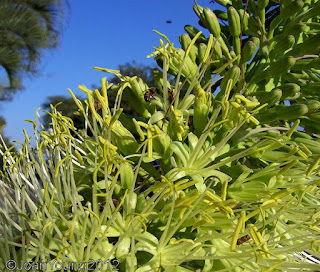Family Asparagaceae
Agave attenuata is a species of agave sometimes known as the "lion's tail", "swan's neck", or "foxtail" for its development of a curved stem, unusual among agaves.
Native to the plateau of central Mexico, as one of the unarmed agaves, it is popular as an ornamental plant in gardens.The stems typically range from 50 to 150 cm (20–60 in) in length, and eventually old leaves fall off, leaving them naked and visible. The leaves are ovate-accuminate, 50–70 cm (20–28 in) long and 12–16 cm (5–6 in) wide, pale in color, ranging from a light gray to a light yellowish green. There are no teeth, nor terminal spines, although the leaves taper to points that fray with age. The inflorescence is a dense raceme 2.5 to 3 meters (8 to 10 ft) high, with greenish-yellow flowers.
The original specimens were sent to Kew by the explorer Galeotti in 1834, from an unspecified location in central Mexico.
More recent study has reported it from Jalisco east to Mexico, in small colonies at elevations of 1,900 to 2,500 meters (6,200 to 8,200 ft), but there have been few sightings, suggesting this agave is rare in the wild.
In cultivation, Agave attenuata is said to prefer relatively moist loamy soil, although it can cope with poor soil and dry conditions. It should be protected from direct sunlight in summer and from long periods of frost.






